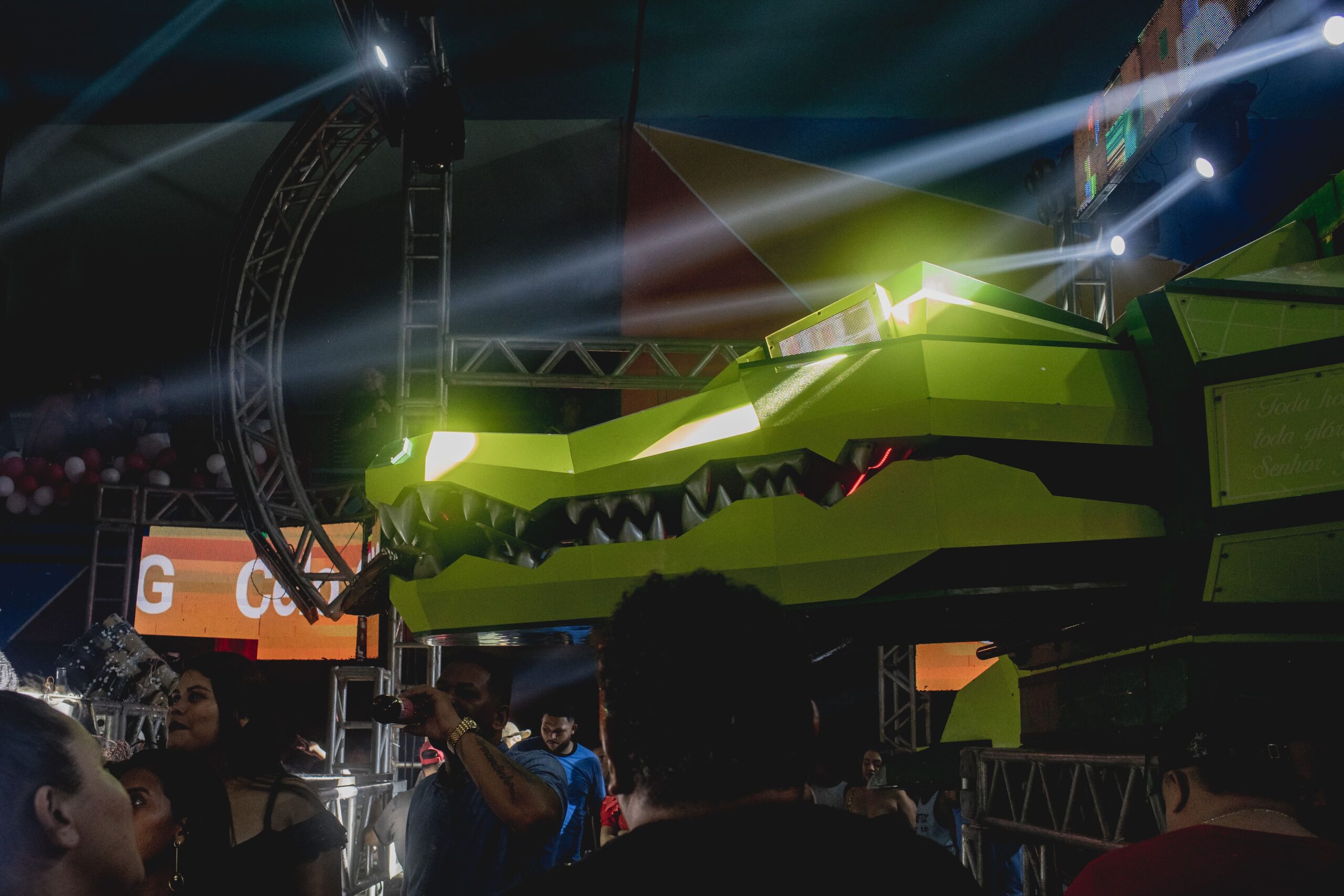Scoping Out Aparelhagem Research
Scoping out existing research and documentation on sonic street technologies is an essential starting point for any further investigation. For this reason, SST has committed to publishing annotated bibliographies on the various sound system scenes across the globe. These bibliographies are meticulously compiled by local researchers and include not only academic publications but also films, social media channels, and digital archives produced within the scene. Following the publication of works on reggae sound systems in Jamaica and the UK, picós in Colombia, radiolas in Maranhão, and Canada’s sound system archive, SST Brazil researchers Natalia Figueredo and Maria Luiza de Barros have compiled an annotated bibliography on aparelhagens in Brazilian Amazonia, available at this link. In this blog they take us through this work by highlighting trends and gaps in the existing aparelhagem research.
by Natalia Figueredo and Maria Luiza de Barros
The literature review Aparelhagem: The Music Technology of Urban Amazonia offers a snapshot of the state of art of existing research aparelhagem, the unique sonic street technology of urban Amazonia (see this previous blog). To conduct this work, we utilised the framework developed by SST, thus categorising materials on aparelhagem into four categories: scientific sources, audiovisual resources, grey literature (both print and online), and social media channels.
Regarding the state of academic research, there are relatively few studies or projects that focus exclusively on aparelhagem. Most existing research considers aparelhagens as part of the broader tecnobrega music scene. Although these studies primarily focus on music, they also highlight the network of individuals, enterpreises and cultural practices that constitute what is known as ‘aparelhagem culture’—a cultural ecosystem where the music genre (tecnobrega) and the sound system (aparelhagem) are deeply interconnected.
Tecnobrega, also known as “music of aparelhagem”, is a highly danceable electronic music genre that, like the sound systems designed to play it, relies on forms of technological appropriation to facilitate music production. These academic resources, therefore, reveal the inseparable connection between the music genre, the sound systems, and the territory.
While these projects facilitate analysis from various perspectives, including an understanding of the parties and their attendees, they also underscore the distinctiveness of Amazonian geography compared to other regions of Brazil or the world. Additionally, they enable the exploration of the different elements that make up the aparelhagem ecology. These can be grouped around three main perspectives: geographical, geopolitical, and social.

Aparelhagem Super Pop fire show at Mangueirão Stadium, Belém, 2023. Image © Natalia Figueredo.
A Peripheral Culture
A crucial aspect of understanding the cultural dynamics of the region is the perceived subaltern status of Amazonia compared to other areas of Brazil, such as the South and Southeast. This perception significantly influences the cultural production of aparelhagem, which is shaped by the unique geographical and social context of the Amazon region. In this setting, music and festivity serve as forms of cultural affirmation.
In the article Amazonian Sound Systems: Cyborgs, Indians, and the Future of the Future, Darien Lamen explores how musical practices in the Amazon challenge narratives of marginality, proposing new ways to understand modernity and culture in the region. His film on the history of Milton Almeida and the Alvi Azul sound system, the documentary Hoje Estamos Aqui (2021), also provides insight into how sound technologies and music function as means of cultural resistance.
This condition of subalternity has also facilitated connections between Amazonian territories, the Afro-diaspora, and globalisation in various ways. The aparelhagem ecosystem represents a cosmopolitan culture shaped by the circulation of global sound technologies and their local adaptation, as these communities appropriate these technologies for their own benefit. Thus, aparelhagens emerge from the creative interplay between local traditions and global influences, illustrating the adaptability and innovation of communities on the periphery of capitalism.
Two key references investigating the interplay of the local and the global in aparelhagem culture are: Rodrigo Moreira Magalhes’ ethnographic work on parties, which explores how these events unfold in terms of sociability and an economy that challenges traditional hierarchies and forges local connections with global influences; and Andrey Faro de Lima’s study, which examines the relationship between Caribbean music and Pará music, analysing the region’s colonial history, port activity, and globalisation dynamics.
Aparelhagens are itinerant music machines playing tecnobrega. Therefore, the music they play is a fundamental part of their cultural practice. Tecnobrega is the electronic evolution of brega, which has been considered since the 1960s as a “low-quality” music genre. This reputation stems from brega’s intrinsic links to working-class communities and the urban peripheries in various parts of Brazil. Other factors contributing to this perception include the standardisation of the contemporary popular music industry and an emphasis on imitation rather than creativity. As a descendant of this stigma, tecnobrega, like the culture of aparelhagem, is frequently perceived as a poor, trashy, or simplistic music.
This stigma contributes to both academic and social prejudice towards the subject, either by diminishing its relevance for research or by treating it in a predatory and exoticised manner. Therefore, understanding the role of aparelhagens in Brazilian culture necessitates engaging with literature addressing concepts such as “popular culture,” “peripheral culture,” or “poor musical taste” within the country. In this context, it has been essential for this review to consider works such as Paulo Murilo Guerreiro do Amaral’s thesis Estigma e cosmopolitismo na constituição de uma música popular urbana de periferia: Etnografia da produção do tecnobrega em Belém do Pará [Stigma and Cosmopolitanism in the Constitution of an Urban Popular Music of the Periphery: Ethnography of Tecnobrega Production in Belém do Pará].
It is important to note that Brazilian historiography already includes several works addressing themes related to peripheral cultures, such as Paulo César Araújo’s Eu Não Sou Cachorro, Não. This book, for example, explores brega music and the challenges faced by artists from Brazil’s peripheries during the military dictatorship (1964-1985), highlighting how popular culture, often marginalised, becomes a tool of resistance and expression for subordinate classes.
Despite its historical stigma, the culture of aparelhagem represents resilient and innovative forms of cultural expression. Therefore, academic literature that delves into the complex web of social, geographical, geopolitical, and cultural connections shaping musical practices in the region enables a more profound understanding of sound system culture within the Amazonian context.

Aparelhagem Crocodilo at Karibe Show Club, Belém, 2017. Image © Bruna Brandão.
The technological apparatus
To understand the technological history of the aparelhagem, it is essential not only to consult academic literature but also to engage with other forms of media and interact with individuals directly involved in the scene, such as DJs, builders, and sound system owners. In this context, accessing audiovisual records—including podcasts, documentaries, news reports, social media, and YouTube archives—is crucial to the discussion. As most aparelhagens are family-run businesses passed down through generations, their histories provide a valuable means of tracing the evolution of the equipment over time.
The visual and oral records of the evolution of aparelhagens provide insights into different types of systems, such as the origins of Pará’s Sonoros, or sounds from bars, automotive sound systems, among others. Their evolution also reflects the cosmopolitan nature of this culture, which evolves in response to local cultural contexts while at the same time interacting with global cultural trends. For instance, the Instagram account @aparelhagemdasantigas allows us to follow the evolution of the equipment, and the podcast Pavulagem #4: Brega, Tecnobrega e Melody analyses the musicality and development of contemporary genres. Additionally, the documentary Brega SA demonstrates how the circuit developed by the production chain around sound systems and tecnobrega serves as a significant reference for the production of cultural goods.
This topic, concerning the use of technology in the Global South, can be situated within a broader discussion on peripheral culture in Brazil, as analysed by researcher GG Albuquerque in the podcast Música Negra do Brasil: #7 Tecnologias do Beat. In this podcast, the researcher explores how new digital technologies have transformed the soundscape of Black and peripheral music in Brazil since the 2000s, subverting sonic technologies and redefining electronic music. Similarly in the article Por uma história da música eletrônica popular brasileira [For a history of Brazilian popular electronic music] in the blog O Volume Morto, Albuquerque examines the evolution of electronic music in Brazil, emphasising how this music scene developed in dialogue with Brazilian popular culture and under the influence of various musical genres, such as carioca funk and tecnobrega.
The importance of sound technologies for peripheral culture in Brazil opens up opportunities for further analysis of creativity, production processes, and sonic aesthetics capable of capturing and transforming everyday experiences into sound and rhythm.

Light show from aparelhagem Carabao’s session at Mangueirão Stadium, Belém, 2023. Image © Natalia Figueredo.
Aparelhagem culture as a part of the city landscape
Some artists have been sharing their stories through various mediums, such as Zek Picoteiro, who conducted a workshop in which he employs the narrative style common among stereo DJs—also found in funk and hip-hop—to recount the evolution of brega. In 2024, Zek in partnership with the Psica festival, through the Regatão Amazônia Institute, organised the first tecnobrega and aparelhagem festival.
Another example is Nay Jinknss, a Black lesbian woman born and raised in Ananindeua, Pará. In 2023, she exhibited a video entitled O brega como empoderamento do paraense at Arte Pará that portrays brega as a tool of empowerment for the people of Pará. In the video, in addition to a soundtrack made up of striking bregas, workers from the Ver-o-Peso Market appear. The artist also seeks to debate dance as a ritual of resistance.
The understanding of aparelhagem culture as a resource that allows Amazonians to explore different forms of self-expressions has led to the emergence of projects such as Altar Sonoro. This project highlights the aparelhagem tradition to showcase the diverse cultural expressions that arise from this practice within Belém’s urban landscape. Altar Sonoro primarily achieves this through audiovisual documentation of everyday life, drawing attention to the subtleties of this culture that shape local life and spatial dynamics in ways that are often overlooked.
The Periphery is the Center
Aparelhagem culture serves as one of the means through which Amazonians create, represent, and circulate their own cultural identity. By appropriating sound technologies and fostering a sense of collectivity, alternative sonic landscapes are constructed, where electronic crocodiles and buffaloes facilitate the (re)construction of (Brazilian) identity from the periphery and impoverished neighbourhoods. The project Galera da Lage ou Gravando um Álbum de Tecnobrega, produced by Companhia Amazônica de Filmes in 2013, is a short documentary that highlights the collective mobilisation in the process of recording a tecnobrega album. Gaby Amarantos, the main character of the film, is currently one of the biggest names in the Brazilian music scene, expanding relations beyond tecnobrega and reinforcing the strong connection between the lifestyle (e.g. aesthetics, fashion, slang) of Northern Brazil and national pop culture, for example.
An influential movement, aparelhagem culture fosters the development of more inclusive and heterogeneous cultural markets by introducing emerging technologies to peripheral regions, enabling practitioners and fans to establish their own systems of identification, production, distribution, and cultural dissemination. Unlike other cultural models in which the periphery relies on the “centre” for validation, aparelhagem culture empowers Amazonians to be the primary agents in defining their own cultural identity.

Dancers at an aparelhagem Rubi party, Belém, 2014. Image © Bruna Brandão.
Further Research Opportunities:
The analysis of the existing sources suggests several possible themes that would merit critical attention in relation to aparelhagem culture. Some of these are:
- The technological apparatus: How it is configured today, beyond its historical evolution.
- Dance: An organic part of the aparelhagem ecosystem, dancing is not just a form of entertainment, but also a means of social expression and embodied sonic knowledge. Dance remains little covered in studies to date.
- Technology and innovation: Delve into how aparelhagens use technology (sound, lights, vehicles) and how these innovations challenge norms and create new techniques and aesthetics. Investigate how skilled techniques, experience and knowledge that engineers, artists and DJs use to adjust the sound system to maximise the intensity of the audience’s audiovisual experience.
- Genre and Music: Critical and historiographical analyses of the relationality and influence of tecnobrega with different genres and musical trends over the years, such as funk melody, electro melody, forró eletrônico, and arrocha.
- Sociodemographic Factors: Demographic data such as race, ethnicity, gender, age, income, etc. These quantitative data directly contribute to more segmented analyses of positive and negative sociocultural (development, appropriations, etc.) and economic (business models, livelihoods, etc.) transformations.
- Knowledge Production: How the ways of knowing and the ways of doing related to aparelhagem culture constitutes ways of being and epistemologies that are not considered by the predominant colonial and elitist knowledge production in academia.
- Methodology, Language, and Narrative: Projects and research that explore the intersection of different methodologies and materials (e.g., quantitative, personal archives, interviews), languages (e.g., audiovisual animation, sound experimentation), and narratives (e.g., critical, descriptive, fictional, poetic) to contribute to the generation of archives and memory of sound systems across different media.
About the Authors:
The authors’ backgrounds significantly contribute to the interdisciplinary and multi-language analysis of the annotated bibliography, allowing for a broad and critical approach in the pursuit of diverse and accessible knowledge on the topic.
Natalia Figueredo is an architect and urban planner (Escola da Cidade – São Paulo), cultural theorist (Goldsmiths University of London), originally from Belém in the Brazilian Amazon. She is currently pursuing a PhD in Culture and Society at the University of Barcelona.
Maria Luiza de Barros is an architect, urban planner, critical theorist, and curator, originally from Espírito Santo (Brazil). She is a PhD candidate in Architecture and Urbanism at the University of São Paulo and the founder of vi.bra.tion, an interdisciplinary research platform for critical perspectives on the city, architecture, language, and sound.
